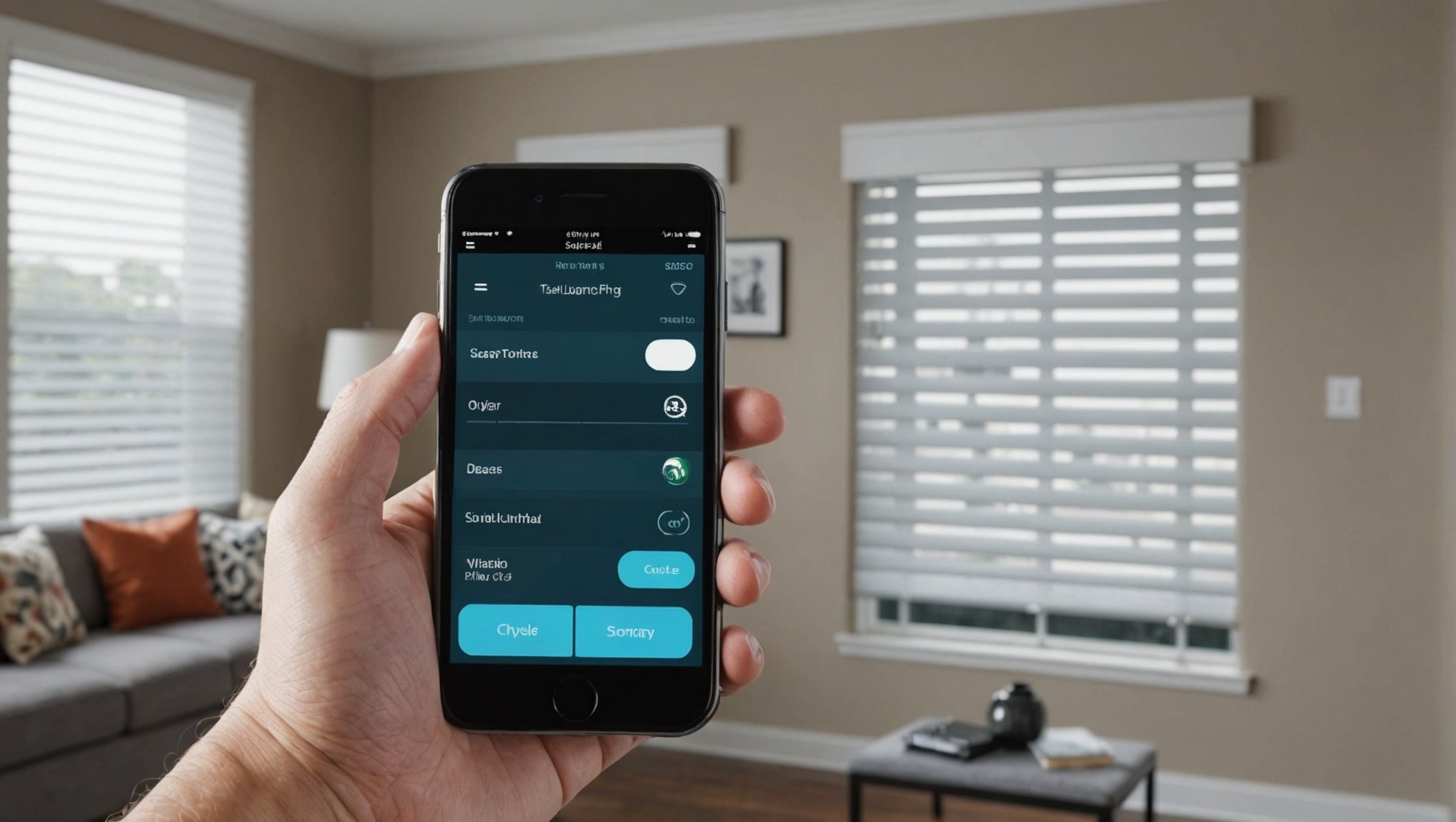Smart blinds offer a seamless blend of comfort and innovation, transforming how we control natural light in our homes. With smartphone integration, users can manage their blinds from anywhere, optimizing energy use and enhancing privacy. This guide unveils essential tips for mastering smartphone control, empowering you to customize your living space effortlessly. Experience the ultimate convenience smart blinds provide, simplifying your daily routines and elevating your home's ambiance. Embrace the future of window treatment technology.
Overview of Smart Blinds
Smart blinds are an innovative home technology that integrates with your smart home system to automate window coverings. These blinds can be controlled through smartphones, voice commands, or even programmed schedules, offering a seamless blend of convenience and functionality. Smart blinds are available in various materials and styles, including wood, fabric, and aluminium, allowing them to complement any interior design while providing advanced features.
Topic to read : Mastering Smart Thermostats: Control and Monitor Room Temperatures Effortlessly with Your Smartphone
The primary benefits of smart blinds revolve around energy efficiency and privacy control. By automatically adjusting based on the time of day or sunlight exposure, smart blinds help regulate indoor temperatures, reducing reliance on heating and cooling systems. This can lead to significant energy savings and a decrease in utility bills. Additionally, smart blinds enhance privacy by allowing users to manage the level of exposure to the outside world without compromising on natural light.
In terms of energy efficiency, smart blinds are designed to make your home more sustainable. They can be programmed to open during cooler parts of the day to let in natural light and warmth, or close during peak sunlight to keep interiors cool. With these features, smart blinds not only enhance comfort but also contribute to an eco-friendly lifestyle.
Also to discover : Maximize Your Smart Home”s Energy Savings: Smart Strategies Using Your Smartphone
Step-by-Step Setup Instructions
Setting up smart blinds can be a straightforward process with the right guidance. This section will provide a comprehensive setup guide to help you get started with ease.
Preparation for Installation
Before you begin, gather the essential tools and materials required for the smart blinds installation. These typically include a screwdriver, measuring tape, and any mounting brackets provided with your blinds. Ensure you have a stable internet connection, as this will be necessary for connecting your blinds to your home network.
Connecting Smart Blinds to Smartphone
To enable smartphone control, download the relevant app for your smart blinds. This can usually be found in your device's app store. Once installed, open the app and follow the on-screen instructions to connect your blinds to the app. This process might involve scanning a QR code or entering a unique code provided with your blinds.
Initial Configuration and Calibration
After establishing a connection, proceed with the initial configuration. This involves setting up schedules and preferences for your blinds. Calibration is crucial for optimal performance. Adjust the blinds to ensure they open and close smoothly. Some apps offer a calibration feature that guides you through this process, ensuring your blinds function precisely as intended.
Compatibility with Smartphones
Understanding the compatibility of smart blinds with smartphones is crucial for seamless integration into your smart home ecosystem. Smartphone integration ensures you can control your blinds effortlessly from anywhere, using devices you already own.
Overview of Compatible Smartphones and Operating Systems
Most smart blinds are designed to work with a variety of smartphones, including both Android and iOS devices. They typically require a specific app that you can download from your device's app store. It's essential to check that your smartphone's operating system is supported by the smart blinds manufacturer to ensure smooth operation.
Importance of Wi-Fi and Bluetooth for Connectivity
For effective smart blinds compatibility, reliable connectivity is key. Wi-Fi and Bluetooth are the primary technologies used to connect smart blinds to your smartphone. Wi-Fi allows you to control your blinds remotely, while Bluetooth offers a more localized connection, useful when Wi-Fi is unavailable. Both ensure you have full control over your blinds’ functions.
Checking Compatibility with Existing Smart Home Systems
Before purchasing, verify that your smart blinds are compatible with your existing smart home systems, such as Amazon Alexa, Google Assistant, or Apple HomeKit. This integration enhances the utility of your smart blinds, enabling voice commands and automation scenarios that fit seamlessly into your daily routine.
Comparison of Popular Smart Blind Brands
When choosing smart blinds, understanding the differences between popular brands can help you make an informed decision. This section delves into the features, pricing, and customer reviews of leading brands.
Brand A: Features and Pricing
Brand A offers a range of smart blinds with advanced features such as voice control and energy efficiency. These blinds are designed to integrate seamlessly with major smart home systems. Pricing varies based on materials and additional features, making them accessible to different budgets. Customers appreciate the ease of installation and the responsive customer support provided by Brand A.
Brand B: Unique Selling Points
Brand B distinguishes itself with its innovative design and customisation options. Their smart blinds are available in a wide array of colours and materials, allowing for personalisation to suit any home décor. Additionally, Brand B offers a unique solar-powered option, enhancing energy efficiency. This brand is praised for its eco-friendly approach and stylish designs.
Brand C: Customer Reviews
Brand C has garnered positive feedback for its robust performance and reliability. Customers highlight the intuitive app interface and consistent connectivity as standout features. The pricing is competitive, and many users report high satisfaction with the durability and functionality of these smart blinds. Brand C is often recommended for those seeking a blend of quality and affordability.
Troubleshooting Common Issues
Encountering issues with smart blinds can be frustrating, but many common problems have straightforward solutions. Understanding how to troubleshoot effectively can save time and ensure your blinds operate smoothly.
Common Connectivity Issues and Solutions
Connectivity problems often arise with smart blinds, especially when integrating with home networks. Ensure your Wi-Fi is stable and within range of the blinds. If issues persist, try resetting the network settings on both your blinds and router. Verify that the app is updated to the latest version, as updates often include fixes for connectivity bugs.
Addressing Problems with Responsiveness and Calibration
If your blinds are unresponsive or not calibrating correctly, first check for any obstructions in their path. Ensure that the calibration settings in the app are correctly configured. Recalibrate by following the app's guided steps, as this can resolve misalignment and improve responsiveness.
Maintenance Tips to Prevent Future Issues
Regular maintenance can prevent many common problems. Dust and clean the blinds periodically to avoid build-up that can hinder movement. Check for any wear and tear in the mechanisms and replace parts as needed. Keeping software up-to-date ensures optimal performance and reduces the likelihood of future issues.
Integration with Smart Home Systems
Integrating smart blinds with your smart home systems can elevate your home automation experience, offering seamless control and enhanced functionality. This section explores how to connect your smart blinds with various hubs, utilise voice control, and set up automation routines for optimal convenience and energy efficiency.
Connecting to Smart Home Hubs
To begin smart home integration, ensure your blinds are compatible with popular hubs like Amazon Alexa, Google Assistant, or Apple HomeKit. Follow the manufacturer's instructions to connect your blinds to the hub, typically involving the smart home app. Once connected, you can manage your blinds alongside other devices, creating a unified smart home ecosystem.
Voice Control Options
Voice control is a standout feature of smart home integration, allowing you to operate your blinds hands-free. Most smart blinds support commands through virtual assistants like Alexa or Google Assistant. Simply enable the skill or action in the assistant's app, and you can adjust your blinds using simple voice commands, enhancing accessibility and convenience.
Automation Routines
Setting up automation routines can significantly improve energy savings and lifestyle convenience. Program your blinds to adjust based on time, sunlight, or occupancy. For example, schedule them to open in the morning for natural light and close during peak sunlight to maintain a comfortable indoor temperature, reducing the need for artificial heating or cooling.
User Testimonials and Visuals
Smart blinds reviews often highlight their transformative impact on daily life, emphasising both convenience and functionality. Users frequently praise the ease of operation, noting how simple it is to adjust blinds through smartphone apps or voice commands. This integration into everyday routines enhances both comfort and efficiency.
Real User Experiences
Many customers share positive experiences about the energy savings achieved with smart blinds. By automating their blinds to react to sunlight, users report noticeable reductions in energy bills. Privacy control is another frequently mentioned benefit, with users enjoying the ability to adjust their blinds for optimal privacy without sacrificing natural light.
Visual Guide to Installation and Operation
Visual aids can significantly simplify the installation process. Step-by-step images or videos guide users through setting up their blinds, ensuring a smooth experience. These visuals also demonstrate the operation of smart blinds, showcasing features like remote control and scheduling.
Case Studies on Benefits
Case studies provide concrete examples of the advantages of smart blinds. For instance, a family in a sunny region might highlight how automated blinds have kept their home cooler, reducing air conditioning costs. Such testimonials and visuals not only validate the product's benefits but also inspire confidence in potential buyers.











